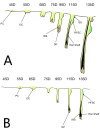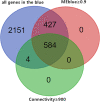Using WGCNA (weighted gene co-expression network analysis) to identify the hub genes of skin hair follicle development in fetus stage of Inner Mongolia cashmere goat
- PMID: 33351808
- PMCID: PMC7755285
- DOI: 10.1371/journal.pone.0243507
Using WGCNA (weighted gene co-expression network analysis) to identify the hub genes of skin hair follicle development in fetus stage of Inner Mongolia cashmere goat
Abstract
Objective: Mature hair follicles represent an important stage of hair follicle development, which determines the stability of hair follicle structure and its ability to enter the hair cycle. Here, we used weighted gene co-expression network analysis (WGCNA) to identify hub genes of mature skin and hair follicles in Inner Mongolian cashmere goats.
Methods: We used transcriptome sequencing data for the skin of Inner Mongolian cashmere goats from fetal days 45-135 days, and divided the co expressed genes into different modules by WGCNA. Characteristic values were used to screen out modules that were highly expressed in mature skin follicles. Module hub genes were then selected based on the correlation coefficients between the gene and module eigenvalue, gene connectivity, and Gene Ontology (GO)/Kyoto Encyclopedia of Genes and Genomes (KEGG) enrichment analysis. The results were confirmed by quantitative polymerase chain reaction (qPCR).
Results: Ten modules were successfully defined, of which one, with a total of 3166 genes, was selected as a specific module through sample and gene expression pattern analyses. A total of 584 candidate hub genes in the module were screened by the correlation coefficients between the genes and module eigenvalue and gene connectivity. Finally, GO/KEGG functional enrichment analyses detected WNT10A as a key gene in the development and maturation of skin hair follicles in fetal Inner Mongolian cashmere goats. qPCR showed that the expression trends of 13 genes from seven fetal skin samples were consistent with the sequencing results, indicating that the sequencing results were reliable.n.
Conflict of interest statement
The authors have declared that no competing interests exist
Figures













Similar articles
-
Identification of Genes Related to Hair Follicle Cycle Development in Inner Mongolia Cashmere Goat by WGCNA.Front Vet Sci. 2022 Jun 14;9:894380. doi: 10.3389/fvets.2022.894380. eCollection 2022. Front Vet Sci. 2022. PMID: 35774980 Free PMC article.
-
Inner Mongolian Cashmere Goat Secondary Follicle Development Regulation Research Based on mRNA-miRNA Co-analysis.Sci Rep. 2020 Mar 11;10(1):4519. doi: 10.1038/s41598-020-60351-5. Sci Rep. 2020. PMID: 32161290 Free PMC article.
-
Comparative Transcriptome Analysis of Fetal Skin Reveals Key Genes Related to Hair Follicle Morphogenesis in Cashmere Goats.PLoS One. 2016 Mar 9;11(3):e0151118. doi: 10.1371/journal.pone.0151118. eCollection 2016. PLoS One. 2016. PMID: 26959817 Free PMC article.
-
Skin transcriptome reveals the periodic changes in genes underlying cashmere (ground hair) follicle transition in cashmere goats.BMC Genomics. 2020 Jun 5;21(1):392. doi: 10.1186/s12864-020-06779-5. BMC Genomics. 2020. PMID: 32503427 Free PMC article.
-
Screening of Skin Lesion-Associated Genes in Patients with Psoriasis by Meta-Integration Analysis.Dermatology. 2017;233(4):277-288. doi: 10.1159/000481619. Epub 2017 Nov 15. Dermatology. 2017. PMID: 29136636 Review.
Cited by
-
Identification of Key Genes Associated with Heat Stress in Rats by Weighted Gene Co-Expression Network Analysis.Animals (Basel). 2023 May 12;13(10):1618. doi: 10.3390/ani13101618. Animals (Basel). 2023. PMID: 37238049 Free PMC article.
-
Chi-miR-130b-3p regulates Inner Mongolia cashmere goat skin hair follicles in fetuses by targeting Wnt family member 10A.G3 (Bethesda). 2021 Jan 18;11(1):jkaa023. doi: 10.1093/g3journal/jkaa023. G3 (Bethesda). 2021. PMID: 33561234 Free PMC article.
-
Unlocking the genetic secrets of Dorper sheep: insights into wool shedding and hair follicle development.Front Vet Sci. 2024 Dec 11;11:1489379. doi: 10.3389/fvets.2024.1489379. eCollection 2024. Front Vet Sci. 2024. PMID: 39726582 Free PMC article.
-
Convergent Genomic Signatures of Cashmere Traits: Evidence for Natural and Artificial Selection.Int J Mol Sci. 2023 Jan 6;24(2):1165. doi: 10.3390/ijms24021165. Int J Mol Sci. 2023. PMID: 36674681 Free PMC article.
-
Identification of Genes Related to Hair Follicle Cycle Development in Inner Mongolia Cashmere Goat by WGCNA.Front Vet Sci. 2022 Jun 14;9:894380. doi: 10.3389/fvets.2022.894380. eCollection 2022. Front Vet Sci. 2022. PMID: 35774980 Free PMC article.
References
-
- Bai J., Zhang Q., Li J., Dao E.J., Jia X., Estimates of genetic parameters and genetic trends for production traits of Inner Mongolian White Cashmere Goat, Asian Australasian J. Anim. Sci. 19 (2006): 13–18.
-
- Klufa Jörg Bauer Thomas, Buck Hanson et al. Hair eruption initiates and commensal skin microbiota aggravate adverse events of anti-EGFR therapy.[J].Sci Transl Med, 2019, 11: undefined. - PubMed
Publication types
MeSH terms
Substances
LinkOut - more resources
Full Text Sources

